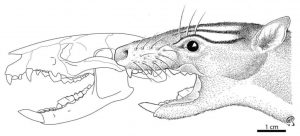
The discovery of three extinct species and new insights to a fourth indicates a little-known family of marsupials, the Palaeothentidae, was diverse and existed over a wide range of South America as recent as 13 million years ago.
The finding, however, complicates the question: why did these animals go extinct?
“It was previously assumed this group slowly went extinct over a long time period, but that’s probably not the case,” said Russell Engelman, a biology MS student at Case Western Reserve and lead author of a new study on the group. “They were doing very well at the time they were supposedly on death’s door.”
Discovering new fossil sites may be the only way to learn the answer, researchers say.
Engelman; along with Federico Anaya, professor of geological engineering at Universidad Autónoma Tomás Frías, in Potosí, Bolivia; and Darin Croft, anatomy professor at Case Western Reserve School of Medicine, describe the animals, where they fit in the family, and their paleoecology and paleobiology in the Journal of Systematic Palaeontology.
Fossils of the new species were found at Quebrada Honda, a high elevation fossil site in southern Bolivia. They are about 13 million years old (from the middle Miocene epoch), placing them among the youngest known palaeothentid fossils.
Fossil remains of other members of the family, and other relatives within the order Paucituberculata, have been found at sites of similar age in southwestern Colombia and possibly southern Argentina, geographically spanning almost the entire continent.
“The only close relatives of palaeothentids alive today are shrew-opossums, small, poorly-known, ground-living marsupials that live in and near the Andes,” Croft said. “Palaeothentid marsupials once included a diversity of species that filled a variety of roles in ancient ecosystems. During their heyday in the Miocene, they were abundant.”
The new species, Palaeothentes serratus, Palaeothentes relictus, and Chimeralestes ambiguus, all had long snouts but differed in diet and body size and other features.
The researchers suggest P. serratus — serratus means saw-like — was an insectivore, with well-developed slicing premolars. The researchers estimate the mouse-size marsupial weighed about 3.5 ounces.
P. relictus had large, well-developed grinding molars. The animal probably ate fruits, seeds and insects, and weighed about five ounces.
C. ambiguus, as the name indicates, has attributes of a number of family members, making its evolutionary relationships with the group uncertain. The animal was about the same size as P. serratus and its limited dental remains indicate its diet was likely similar to that of P. relictus.
The most common member of the family found at Quebrada Honda is Acdestis maddeni. The species was named 14 years ago, but the researchers are the first to find and analyze its lower jaw.
These lower jaw fossils, combined with reexamination of other specimens, show that the skull of Acdestis was different from other palaeothentids. A. maddeni’s snout is short and its canines are relatively large, followed by large, shearing middle teeth and molars well developed for grinding.
“All this indicates it was a generalist,” Engelman said. “Although it could eat fruits and insects like its relatives it could also catch small vertebrates and dismember them… It probably ate anything, like a hedgehog or Norway rat does.”
The animal was rat-size and weighed about a pound, the researchers estimate.
The fossil record indicates the Palaeothentidae and much of the order Paucituberculata abruptly went extinct about 12 million years ago, leaving only the lineage leading to modern shrew-opossums.
“Most species threatened with extinction are like giant pandas: highly specialized, live only in a certain area and eat only certain things,” Engelman said. Due to their diversity and wide range, “the Palaeothentidae didn’t fit the pattern of extinction.”
Previous hypotheses that palaeothentids were done in by climate change or competition lack support, the researchers say.
For example, fossils found at high latitudes in Argentina and Bolivia after the Middle Miocene Climatic Optimum indicate they withstood the dramatic cooling of the period. The family and opossums, which may have been competitors, appear to have overlapped for nearly 10 million years. Yet opossums didn’t become abundant until 3 million to 4 million years after the family went extinct.
But, the hypothesis cannot be completely ruled out, the researchers said. And, there is a possibility the decline of the family was slow.
The reason for the quandary is that fossils have been well collected in the southern end of South America but the middle and northern parts of the continent remain largely unexplored.
“It’s as if all the fossils in the U.S. came from Florida — you don’t get the full picture,” Engelman said.
If new fossil sites are found in the northern two-thirds of the continent, “it will be interesting to see whether we find younger members of the group,” Croft said. “That will help us understand their extinction.”
Reference:
Russell K. Engelman, Federico Anaya, Darin A. Croft. New palaeothentid marsupials (Paucituberculata) from the middle Miocene of Quebrada Honda, Bolivia, and their implications for the palaeoecology, decline and extinction of the Palaeothentoidea. Journal of Systematic Palaeontology, 2016; 1 DOI: 10.1080/14772019.2016.1240112
Note: The above post is reprinted from materials provided by Case Western Reserve University.










